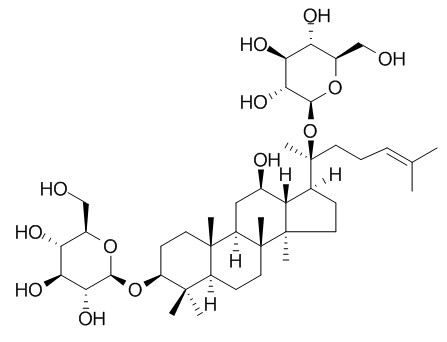Natural Products
Ginsenoside F2
| Catalog No. | CFN99755 |  |
| CAS No. | 62025-49-4 | |
| Molecular Weight: | 785.01 | |
| Molecular Formula | C42H72O13 | |
| DBs | [PubChem]:274951196 [ChEMBL]:77145 [PCIDB]:30389 |
Standard InChI:
InChI=1S/C42H72O13/c1-21(2)10-9-14-42(8,55-37-35(51)33(49)31(47)25(20-44)53-37)22-11-16-41(7)29(22)23(45)18-27-39(5)15-13-28(38(3,4)26(39)12-17-40(27,41)6)54-36-34(50)32(48)30(46)24(19-43)52-36/h10,22-37,43-51H,9,11-20H2,1-8H3/t22-,23+,24+,25+,26-,27+,28-,29-,30+,31+,32-,33-,34+,35+,36-,37-,39-,40+,41+,42-/m0/s1
Biological Activity
Ginsenoside F2 has the anti-cancer activity, it induces apoptosis in breast cancer stem cells (CSCs) by activating the intrinsic apoptotic pathway and mitochondrial dysfunction, also induces the formation of acidic vesicular organelles, recruitment of GFP-LC3-II to autophagosomes, and elevation of Atg-7 levels, suggests that F2 initiates an autophagic progression in breast CSCs. [1]
Ginsenoside F2 suppresses hair cell apoptosis and premature entry to catagen more effectively than finasteride, it decreases the expression of TGF-β2 and SCAP proteins, this study provides evidence those factors in the SCAP pathway could be targets for hair loss prevention drugs.[2]
Ginsenoside F2 could be a new potential chemotherapeutic drug for glioblastoma multiforme (GBM) treatment by inhibiting the growth and invasion of cancer, the anticancer activity might be mediated through inhibition of proliferation judged by Ki67 and apoptosis induced by activation of caspase-3 and -8.[3]
Ginsenoside F2 may reduce obesity via the inhibition of adipogenesis in the 3T3-L1 cell line.[4]
Product
References
[1] Mai T T, Moon J Y, Song Y W, et al. Cancer Lett, 2012, 321(2):144–53.
[2] Shin H S, Park S Y, Hwang E S, et al. Biol Pharm Bull, 2014, 37(5):755-63.
[3] Shin J Y, Lee J M, Shin H S, et al. J Ginseng Res, 2012, 36(1):86-92.
[4] Siraj F M, Sathishkumar N, Kim Y J, et al. J Enzym Inhib Med Ch, 2014, 30(1):9-14.
[5] Zhou W, Li J, Li X, et al. J Sep Sci, 2008, 31(6-7):921-5.
Product Use Citation





